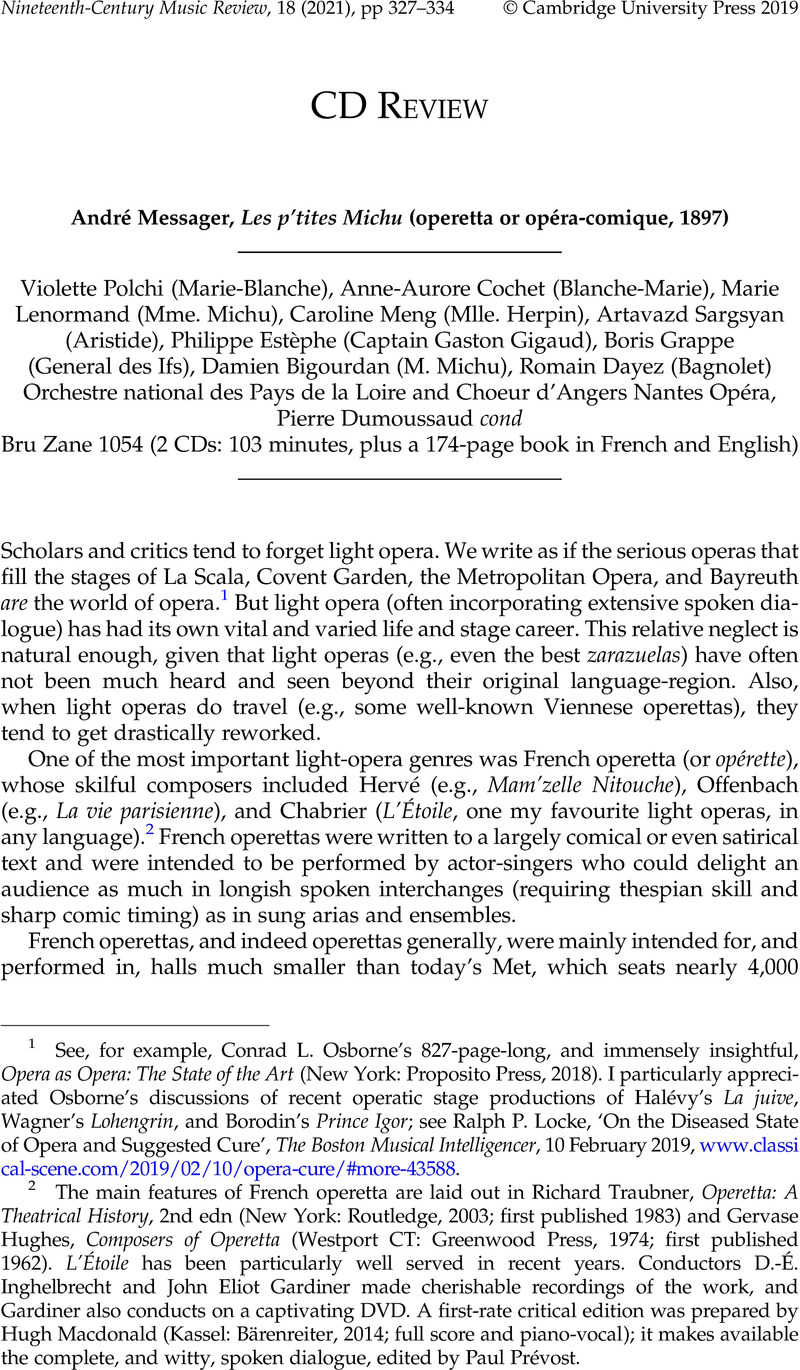Published online by Cambridge University Press: 29 August 2019

1 See, for example, Osborne, Conrad L.'s 827-page-long, and immensely insightful, Opera as Opera: The State of the Art (New York: Proposito Press, 2018)Google Scholar. I particularly appreciated Osborne's discussions of recent operatic stage productions of Halévy's La juive, Wagner's Lohengrin, and Borodin's Prince Igor; see Ralph P. Locke, ‘On the Diseased State of Opera and Suggested Cure’, The Boston Musical Intelligencer, 10 February 2019, www.classical-scene.com/2019/02/10/opera-cure/#more-43588.
2 The main features of French operetta are laid out in Traubner, Richard, Operetta: A Theatrical History, 2nd edn (New York: Routledge, 2003; first published 1983)Google Scholar and Hughes, Gervase, Composers of Operetta (Westport CT: Greenwood Press, 1974; first published 1962)Google Scholar. L’Étoile has been particularly well served in recent years. Conductors D.-É. Inghelbrecht and John Eliot Gardiner made cherishable recordings of the work, and Gardiner also conducts on a captivating DVD. A first-rate critical edition was prepared by Hugh Macdonald (Kassel: Bärenreiter, 2014; full score and piano-vocal); it makes available the complete, and witty, spoken dialogue, edited by Paul Prévost.
3 This brutal episode, in which tens of thousands died on both sides, resulted in Napoleon's brother Joseph being put on the Spanish throne. He ruled Spain in a spirit of ‘enlightened absolutism’ until forced to flee in 1813.
4 The libretto is by experienced theatre professionals Albert Vanloo and Georges Duval.
5 So this work could just as well be interpreted as, at once, a repudiation of social-class atavism and an affirmation of a different kind of stubborn ‘nature’: namely each person's highly individual, deeply embedded behavioural tendencies.
6 Fortunio was recorded under John Eliot Gardiner in 1987. Of these works, Madame Chrysanthème particularly deserves a complete modern recording; it is based on Pierre Loti's novel of the same name, which, soon thereafter, would serve as an indirect source for Puccini's Madama Butterfly (1902–6). Traubner mistakenly states that the music in Madame Chrysanthème is entirely ‘continuous’, with no passages of spoken dialogue (Operetta, p. 213): perhaps he was influenced by the work's sole recording (currently on Cantus Classics 5.01906F), from 1956, which omits nearly all the dialogue.
7 Traubner, Operetta, 214–15 (cf. 220, 296).
8 Traubner, Operetta, 211.
9 Hughes, Composers of Operetta, 91–9 (here 91).
10 Traubner, Operetta, 212: ‘Graceful throwbacks to earlier musical forms … would become a Messager trademark’.
11 Messager was one of several French musicians ‘applauding enthusiastically’ at a concert of Russian music conducted by Rimsky-Korsakov in 1889. (Others present and equally enthusiastic included Fauré and Debussy.) Many Russian works were by this time available for study in the library of the Conservatoire. See Fauser, Annegret, Musical Encounters at the 1889 Paris World's Fair (Rochester: University of Rochester Press, 2005), 43Google Scholar (quoted passage) and 321–2.
12 Ireland's suite is most often heard today in an arrangement for string orchestra.
13 For that matter, was Frederick Loewe recalling the ‘Ah! Quel malheur’ duet (Act 2) in the extended ‘Guenevere’ ensemble number toward the end of Camelot (1960, book and lyrics by Alan Jay Lerner)? The first measures of ‘Ah! Quel malheur’ are in Hughes, Composers of Operetta, 99.
14 I have published reviews of nine of the ‘Opéra français’ releases in the American Record Guide, and some of these reviews are now also available on one or another online site. See, for example, my review of Benjamin Godard's Dante in American Record Guide, March/April 2018, 96–97, now uploaded at www.operatoday.com/content/2019/01/a_first-ever_re.php. Until recently, all of the Centre's recordings were labelled with the name of the Spanish publisher of the shortish book that comes with each set of CDs (namely Ediciones singulares), even though the Centre entirely produced and edited the content. Newer releases, more sensibly, bear the name of the Palazzetto on the front and back and an order number beginning with BZ (i.e., Bru Zane).
15 I reviewed a Gounod ‘Prix de Rome’ 2-CD album (choral works and cantatas) in American Record Guide, July/August 2018, 95, and a ‘Portrait’ 3-CD album of works in multiple genres by Félicien David in American Record Guide, November/December 2017, 100–103, now uploaded to www.classical-scene.com/2019/01/19/felicien-david-revived-digitally/. See review of the same Gounod album by Clair Rowden in Nineteenth-Century Music Review, published online 18 February 2019, doi:10.1017/S1479409818000605.
16 E.g., in Gounod's Le tribut de Zamora (which I reviewed in American Record Guide, January/February 2019, 100–102).
17 Louis-Ferdinand Hérold, Le pré aux clercs, cond. Paul McCreesh, 2 CDs, Ediciones singulares ES 125. (See my review in American Record Guide, September/October 2017, 100–102.)
18 Brief clips from the production can be viewed in the trailer for the recording: www.youtube.com/watch?v=pL9CLNM_eH4.
19 It can be downloaded at www.ina.fr/audio/PHD89024470 (current price: 3.99 Euros). The recording includes newly written narration (to set the scene) and preserves some bits of dialogue that are not on the new recording.
20 Pathé LP DTX30301, Musidisc CD MU 744 (and other re-releases, e.g., on the labels EMI France and M10 – now all out of print). The conductor is sometimes identified in catalogues as Jules Gressier, sometimes as Roger Ellis.
21 Details at WorldCat.org, under OCLC number 690686976.
22 The tenor is identified on the record label as ‘André Noël de l'Opéra-Comique’ (Pathé X.90019/N 203201): www.youtube.com/watch?v=hA5U3fzkSRc.
23 Blanche-Marie's aria, ‘Vois-tu, je m'en veux’, is in French Operetta Arias: C'est ça la vie, c'est ça l'amour, 2002 (Erato 0927–42106–2); the CD was re-released in 2013 by Warner Classics International as Susan Graham Sings French Operetta Arias. The duet, accompanied by pianist Steven Blier, is online at www.youtube.com/watch?v=fAv6Oqki3Vw; mezzo Graham sings the somewhat lower part: that of Marie-Blanche. Traubner proposes that, in this number, ‘[the] Messagerian flow and lyricism over a preponderance of eighth and sixteenth notes is virtually unique’ (p. 214).
Please note a has been issued for this article.